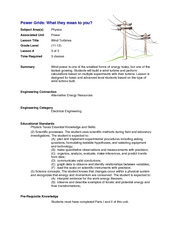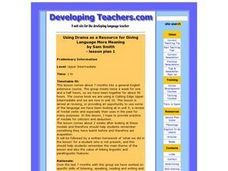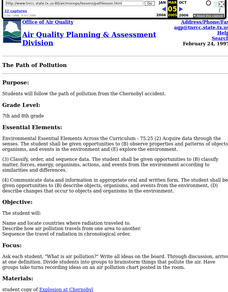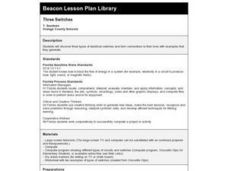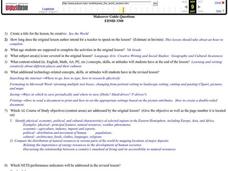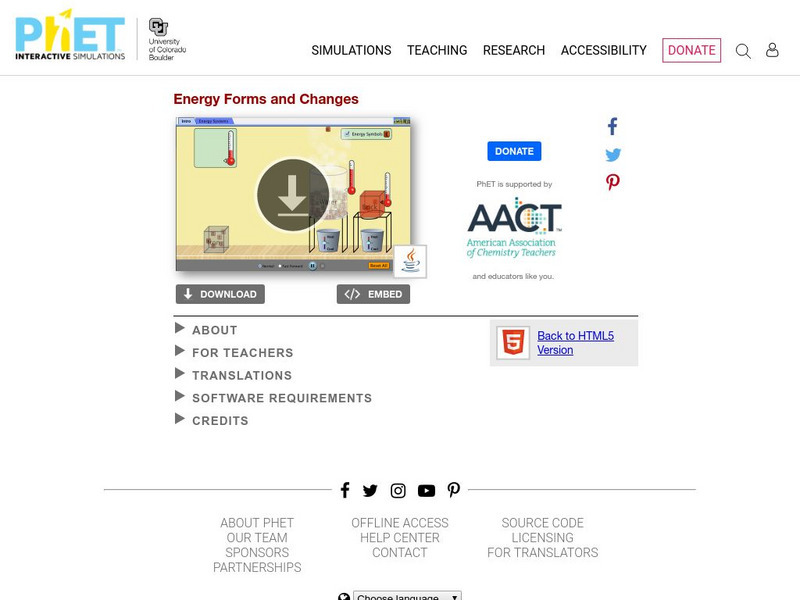Curated OER
Putting on Mass: Just how do Trees grow?
Students articulate an explanation of photosynthesis. They identify problems they have with comprehension of how a plant gains mass. Students describe a historical experiment.
Curated OER
Storm That Drowned a City
Middle schoolers watch a teacher demonstration modeling how wetlands can help reduce a hurricane's impact and describe what the model represents. They record data related to how different meshed materials affect a steam plume. Students...
Curated OER
Wind Turbines
Students build their own wind turbine. In this physics instructional activity, students calculate the power output of their wind turbines. They evaluate their design and make the necessary modifications.
Curated OER
Powered Up About Electricity!
Students study the process of turning coal into electricity. In this electricity lesson, students are guided by their teacher through the steps required to turn coal into electricity. Students complete a worksheet answering questions...
Curated OER
Jell-O Optics
Students observe an activity with Jell-O to learn about optics. In this investigative lesson students fill out a handout on the activity that helps them to investigate the index of refraction and the speed of light.
Curated OER
Match the Environment Group with the Correct Sector
Students identify different types of environmental organizations. They connect each organization to one of three economic sectors. They examine how each organization is different in their goals and purposes.
Curated OER
A Snapshot in Time
Students state the main ideas of the article. They create questions to clarify the meaning of the article and to help explain the ideas. Students cite words or phrases that reveal a bias the author may have.
Curated OER
A Model of Three Faults
Students investigate faults. In this science lesson, students explore the many stresses and strains in the earth's layers and research the types of faults in their state.
Curated OER
DNA Fingerprinting
Students experiment with chromatography as a technique which is similar to electrophoresis that scientists use to identify DNA samples.
Curated OER
Using Drama as a Resource for Giving Language More Meaning
Students revise and provide spoken and written practice of modal verbs in the past for criticism.
Curated OER
The Communications Lab
Students build and test a type of communication system called a parabolic-dish receiver. This type of system is exactly like radio telescopes, which are discussed in our song. They explain how signals are transmitted and captured with...
Curated OER
Anaerobic Lactic Acid System Exploration
Students explore the role, functions, and conditions in which lactic acid is produced. They share ideas to complete a KWL on the vocabulary for the lesson then research these ideas futher on the internet using a set of prompting...
Curated OER
Oil Trap Model
Students investigate oil accumulation by creating a model in their classroom. In this petroleum geology lesson, students discuss where oil comes from and why it is vital to our society at this particular time. Students cut out a 3-D...
Curated OER
The Path of Pollution
Students follow the path of pollution from the Chernobyl accident. Students name and locate countries where radiation traveled to, describe how air pollution travels from one area to another, and seqence the travel of radiation in...
Curated OER
The Reason for the Seasons; Science, Geography
Students think about what causes the seasons to change, reflect on what they know about seasons and how their lives affected by seasonal changes.
Curated OER
Three Switches
Students describe the types and parts of a circuit. They discover three types of electrical switches and create a chart showing the many uses for each type of switch.
Curated OER
Cloud Shadows
Learners classify clouds as transparent, translucent or opaque. They conduct an experiment to determine the visual opacity of several classroom objects and then conduct further observations of clouds.
Curated OER
Getting Help, but for More Work?
Fifth graders discuss prior knowledge of slope and force. They relate steepness of slope to the force needed to get an object up the slope. Students read from their text the information about inclined planes. They answer the questions...
Curated OER
See the World
Seventh graders locate and write creatively about different places and their cultures. They identify the physical, economic, social, political and cultural characteristics of selected regions in the Eastern Hemisphere. Finally, 7th...
Curated OER
Water
Students examine water, its function and how much you should consume. In this water lesson students study water and why it is important, how much you should drink and what its functions are in your body.
US Energy Information Administration
U.s. Eia Energy Kids: What Is Energy: Forms of Energy
Government energy information site provides users with an understanding of what energy is, the forms of energy, energy efficiency, sources of energy as well as the Law of Conservation of Energy.
University of Colorado
University of Colorado: Ph Et Interactive Simulations: Energy Forms and Changes
Explore how heating and cooling iron, brick, and water adds or removes energy. See how energy is transferred between objects. Build your own system, with energy sources, changers, and users. Track and visualize how energy flows and...
Annenberg Foundation
Annenberg Learner: Science in Focus Energy: What Is Energy?
A video workshop looking at the concept of energy. Discussions include energy as it is used in everyday language to the complex scientific meaning of energy. Presents common student misconceptions, history, and the importance of energy...
Khan Academy
Khan Academy: Energy Through Time
The quest for energy has always been a balancing act. As humans have gained greater control over their environment, they've found abundant resources - and faced numerous challenges. This article traces the history of our quest for energy.


